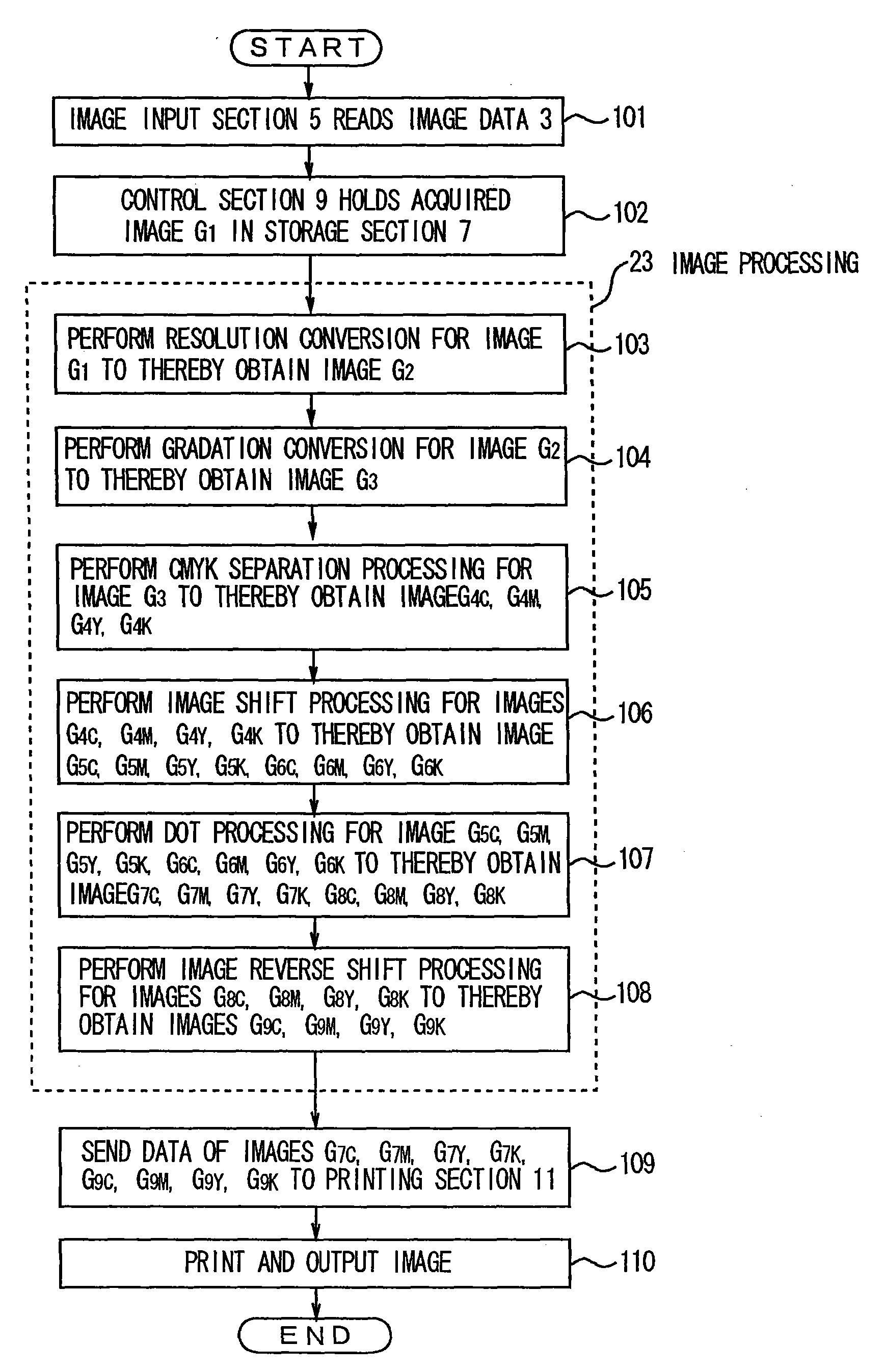Thermal recording apparatus, image forming method, and printed object
a recording apparatus and image technology, applied in the field of thermal recording apparatus, can solve the problems of difficult control of gradation on the pixel, density of dots, etc., and achieve the effect of reducing the printing miss of the white backing and adhesion failur
- Summary
- Abstract
- Description
- Claims
- Application Information
AI Technical Summary
Benefits of technology
Problems solved by technology
Method used
Image
Examples
second embodiment
[0109]Next, the thermal recording apparatus of the present invention will be described.
[0110]In the second embodiment, the structure and the processing details of the thermal printer 1 are generally the same as those in the first embodiment shown in FIGS. 1 and 2.
[0111]The second embodiment differs from the first embodiment in the image shift processing (step 106 of FIG. 4) of the image processing 23. That is, in the second embodiment, the number of pixels by which image data are shifted is changed on a color-by-color basis among cyan (C), magenta (M), yellow (Y), and black (K). Thus, steps formed when images of the respective colors are overprinted in a dot-on-dot fashion are decreased, and printing miss and adhesion failure can be eliminated.
first embodiment
[0112]The flow of the processing is identical with that of the first embodiment from step 101 to step 105 of FIG. 4. That is, after having read the image data 3 through the image input section 5 (step 101), the control section 9 holds the acquired image G1 31-1 in the image memory 27 of the storage section 7 (step 102). Subsequently, the control section 9 performs the resolution conversion processing; i.e., converts the resolution of the image G1 31-1 in accordance with the resolution of the thermal printer 1 to thereby produce the image G2 31-2 (step 103). The control section 9 then performs the gradation conversion; i.e., converts the gradation of the image G2 31-2 to thereby produce the image G3 31-3 (step 104), and converts the image G3 31-3 to CMYK data (CMYK separation processing) to thereby produce the image G4 31-4 (step 105), and stores it in the image memory 27 of the storage section 7.
[0113]The image G4 31-4 obtained through the gradation conversion is composed of four im...
third embodiment
[0139]Next, the thermal recording apparatus of the present invention will be described.
[0140]In the third embodiment, the structure and the processing details of the thermal printer 1 are generally the same as those in the first embodiment shown in FIGS. 1 and 2.
[0141]In the third embodiment, through partial modification of the flow of the image processing 23, the black (K) image or / and the yellow (Y) image are printed in single tone, to thereby increase the speed of the image printing 25 at the printing section 11, and reduce the amount of a material, such as ink, used for the printing.
[0142]The reason why the black (K) image, for example, may be printed in single tone is that in many cases black (K) is used at edge portions of an image, and it is unnecessary to obtain a smooth halftone image through double-tone printing. Further, since yellow (Y) is not noticeable in the printed image, in many cases, no problem arises even when the yellow (Y) image is printed in single tone.
[0143]...
PUM
 Login to View More
Login to View More Abstract
Description
Claims
Application Information
 Login to View More
Login to View More - R&D
- Intellectual Property
- Life Sciences
- Materials
- Tech Scout
- Unparalleled Data Quality
- Higher Quality Content
- 60% Fewer Hallucinations
Browse by: Latest US Patents, China's latest patents, Technical Efficacy Thesaurus, Application Domain, Technology Topic, Popular Technical Reports.
© 2025 PatSnap. All rights reserved.Legal|Privacy policy|Modern Slavery Act Transparency Statement|Sitemap|About US| Contact US: help@patsnap.com



